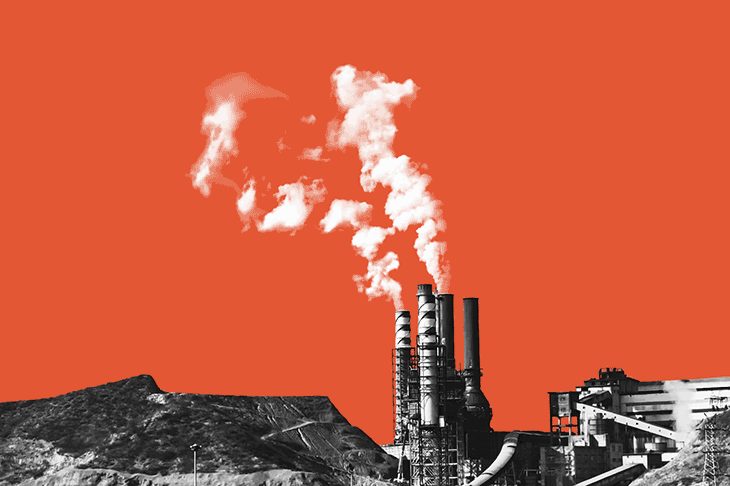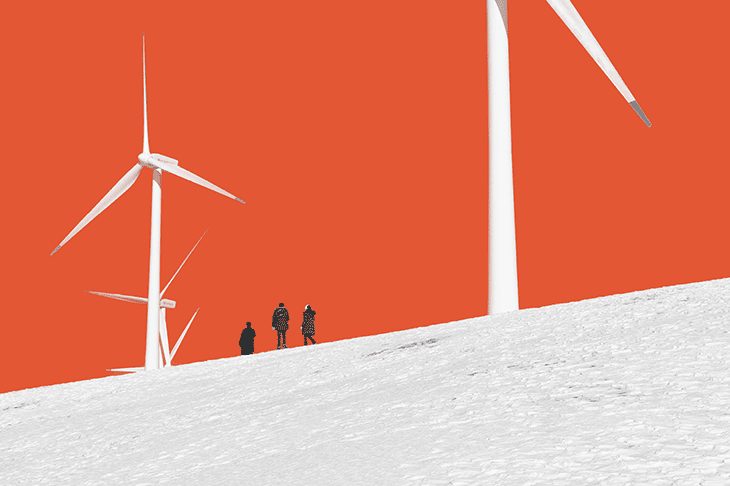Dig into the longer version of our ‘Climate Solutions Reporting Guide,’ produced in collaboration with Solutions Journalism Network, for more story ideas, reporting examples, and resources. This resource is available in Spanish here.
So far, most climate coverage has focused on the problem, but that’s only part of the story. Audiences also need to know that the climate crisis is solvable. Without sugar-coating the facts, our reporting should tell the entire climate story: what’s wrong, but also how it could be fixed. That’s both good journalism and what audiences say they want.
To avoid catastrophic temperature rise, humanity’s emissions of heat-trapping gases must be cut roughly in half within the next decade and reach “net zero” by 2050. Because we waited so long to confront climate change, reaching this goal will require nothing less than radical change. We must rapidly phase out oil, gas, and coal. We must reverse deforestation. We must shift from an industrial model of agriculture to climate-friendly methods. And much more.
The good news? We already possess most of the necessary know-how and technologies. The challenge is to implement solutions, fast. Which hints at a key mistake to avoid in your reporting: Resist the temptation to focus more on techno-fixes than on the political and economic battles that decide whether those fixes get enacted. (See the ‘Politics’ section, below, for further guidance.)
And remember: Climate solutions are particularly urgent for the people who suffer disproportionately from the climate crisis: the poor, people of color, Indigenous people, women, children, the elderly, people with disabilities, and future generations. These communities have contributed the least to the pollution that is overheating the planet, yet often bear the brunt of the impacts and have less financial resources to cope. Some of these communities nevertheless have records of effective climate action.
A Framework for Climate Solutions Reporting
Solutions journalism is evidence-based reporting about problems facing society. The aim is to investigate and hold accountable the solutions put forth by governments, businesses, scientists, activists, and other stakeholders. Here, we group climate solutions into five categories: politics, economics, technology, civil society, and culture.
JUMP TO CLIMATE SOLUTIONS STORY CATEGORIES
Politics and Government
Defusing the climate emergency will require government policies that rapidly phase out fossil fuels, stop deforestation, encourage clean energy and climate-friendly farming, and help people and economies adapt to climate impacts that cannot be avoided. What government officials do, and don’t do, is therefore fundamental — and a rich source of solutions-oriented stories.
Solutions reporting should scrutinize how well governments at all levels — from local to global — are pursuing what scientists say is needed to curb global heating. That includes interrogating the potential of a given tax or subsidy proposal to slash emissions — and, if the facts warrant it, identifying some proposals as “false solutions.” Spotlighting forces blocking climate action is another form of solutions reporting.
For example, in the US the Inflation Reduction Act provides some $369 billion of incentives for producers and consumers to embrace clean energy. But the law does nothing to limit oil, gas, and coal usage, and thus falls short of what science requires. That weakness reflects the fact that Senate Republicans unanimously opposed the bill, which gave West Virginia Democrat Joe Manchin a virtual veto over the final text. Good solutions coverage illuminates not only what a given reform could achieve, but also what’s needed to get that reform passed and enforced.
Questions to get started:
- Where do your local elected officials — from mayors and city council members to state legislators — stand on climate change? What policies do they endorse and oppose, and how do those policies square with what science tells us?
- Who are the key non-governmental voices in your area advocating climate action? Who are they pressuring (governments, companies), and how successful have they been?
Economics and Business
What companies and consumers do, and don’t do, will profoundly affect how much hotter Earth gets. Their behavior, in turn, is strongly influenced by the economic policies that governments implement, including subsidies, investments, taxes, and regulations.
Despite its shortcomings, the IRA offers a cornucopia of local solutions stories. Already the law has spurred the construction of scores of factories producing solar panels, storage batteries, and other climate-friendly technologies while creating more than 110,000 clean energy jobs. Check this data tracker, compiled by the nonprofit Climate Power, to find projects in your area. See also CCNow’s press briefing on covering the roll-out of the IRA.
Another angle to explore: pledges to achieve “net zero” emissions. “Net zero” means that a country or company will produce no more emissions than it “offsets” by making (or financing) reductions elsewhere — for example, by paying someone to plant trees. Serious questions, however, have been raised about the effectiveness of carbon offsets, including in this segment by CBS News’ national climate correspondent Ben Tracy.
Questions to get started:
- How much does the government in your area subsidize fossil fuel companies, including via tax loopholes? What are the barriers to cutting subsidies?
- How are electric utility companies enabling or inhibiting a greener power grid? Are they making it easy, or hard, for property owners to install solar panels?
Technologies and Practices
Technological solutions to the climate emergency are abundant and often economically superior to fossil fuels. The most comprehensive list of scientifically solid, financially viable, and scalable practices and technologies comes from the nonprofit Project Drawdown.
These climate solutions fall into two main categories: mitigation and adaptation.
Mitigation refers to actions that reduce the amount of heat-trapping gases in the atmosphere and oceans. The most important method is to cut ongoing emissions of carbon dioxide, methane, and other heat-trapping gases. A second task is also critical: drawing down the amount of these gases already in the atmosphere and oceans. Known as “carbon dioxide removal,” CDR can be done naturally via plants and soils and also via manmade technologies, though the latter are far from commercially viable. (Caution: Do not confuse CDR with carbon capture and storage, which captures CO2 before it escapes from a chimney or tailpipe but does not reduce the amount of CO2 already in the atmosphere.)
Adaptation solutions increase the resilience of people, businesses, and communities to climate impacts that can no longer be avoided. Running power lines underground to reduce fire risks from drought is one example. Building sea walls or relocating buildings away from the shoreline to protect against stronger storms and rising seas is another. Funding community “cooling centers” where people without air conditioning can shelter during heat waves is a third.
Questions to get started:
- Switching to more energy efficient vehicles and appliances is one of the most powerful climate solutions. Which companies and government agencies are doing the most to help local consumers and businesses switch to heat pumps, electric vehicles, and other ways to reduce their carbon emissions?
- Are there farmers in your area who are shifting their food production practices to cope with climate impacts and/or to reduce emissions?
- What actions are being taken to protect vital infrastructure — subways, roads, airports, water systems, and the electricity supply — in your area?
- How are hospitals, first responders, fire departments, and chief resilience officers preparing — or not — for climate change?
Civil Society
Schools, religious institutions, community groups, nonprofits, labor unions, philanthropic organizations, grassroots activists, the news media, and ordinary people are all part of civil society — and they all can be part of climate solutions. Here, potential solutions include voting, lobbying elected officials, funding an activist group, joining a protest march, hosting a public forum, and talking about climate change with one’s family, friends, neighbors, and co-workers.
Journalists should treat climate activists as newsmakers, covering them accurately when they do something newsworthy while also holding them accountable. Coverage should make plain the activists’ goals and why they think their methods will achieve it, but also interrogate such claims.
Questions to get started:
- What do people in your area know and believe about climate change, and how does that compare with other parts of the US?
- Are people talking about climate change with their family, friends, and co-workers? How are they learning from each other, and what are the stumbling blocks?
- Have people reduced their fossil fuel consumption, perhaps by taking public transit or buying an electric vehicle?
- Are people changing their diets to fight climate change? How are restaurants responding?
Culture
Culture, broadly defined, shapes people’s thoughts and inspires them to action. In recent years, more artists, sports figures, and entertainers are bringing attention to climate change through music, movies, TV, literature, and the visual arts. Covering cultural expression helps the climate story reach new audiences.
Questions to get started:
- How is the climate emergency reflected in new art, literature, music, and film?
- What, specifically, are actors, artists, and musicians doing to fight climate change through their work? Are they changing their own consumption habits to respond to the crisis?
- Are universities, museums, and other cultural institutions in your area funded by climate deniers, and if so, are those institutions under pressure from activists to cut ties with such actors?
Resources
Opinions and beliefs: Yale Program on Climate Change Communication conducted research in 2021 on Americans’ climate change beliefs, risk perceptions, and policy support at the state, congressional district, metro area, and county levels. Visit their “Climate Opinion Maps” to see local results. In December 2022, Yale polled registered US voters on a variety of domestic climate and energy policies.
Projects and jobs: The advocacy group Climate Power is tracking clean energy projects, and the associated new jobs created, since the IRA passed. See their public dataset. More on their methodology can be found in Clean Power’s recent report, “Clean Energy Boom.”
Solutions by sector: Project Drawdown tracks technologies and practices that can help reduce greenhouse gases in the atmosphere. Their “Table of Solutions” can help spark story ideas.
Local action: The C40 & Climate Mayors Guidebook, helps local leaders understand funding available through the IRA. The guide can be useful for journalists to better understand the various local incentives offered and to question officials on what benefits they are or aren’t taking advantage of.
Stories: Check out Solutions Journalism Network’s story tracker to find climate solutions stories sorted by topic.



